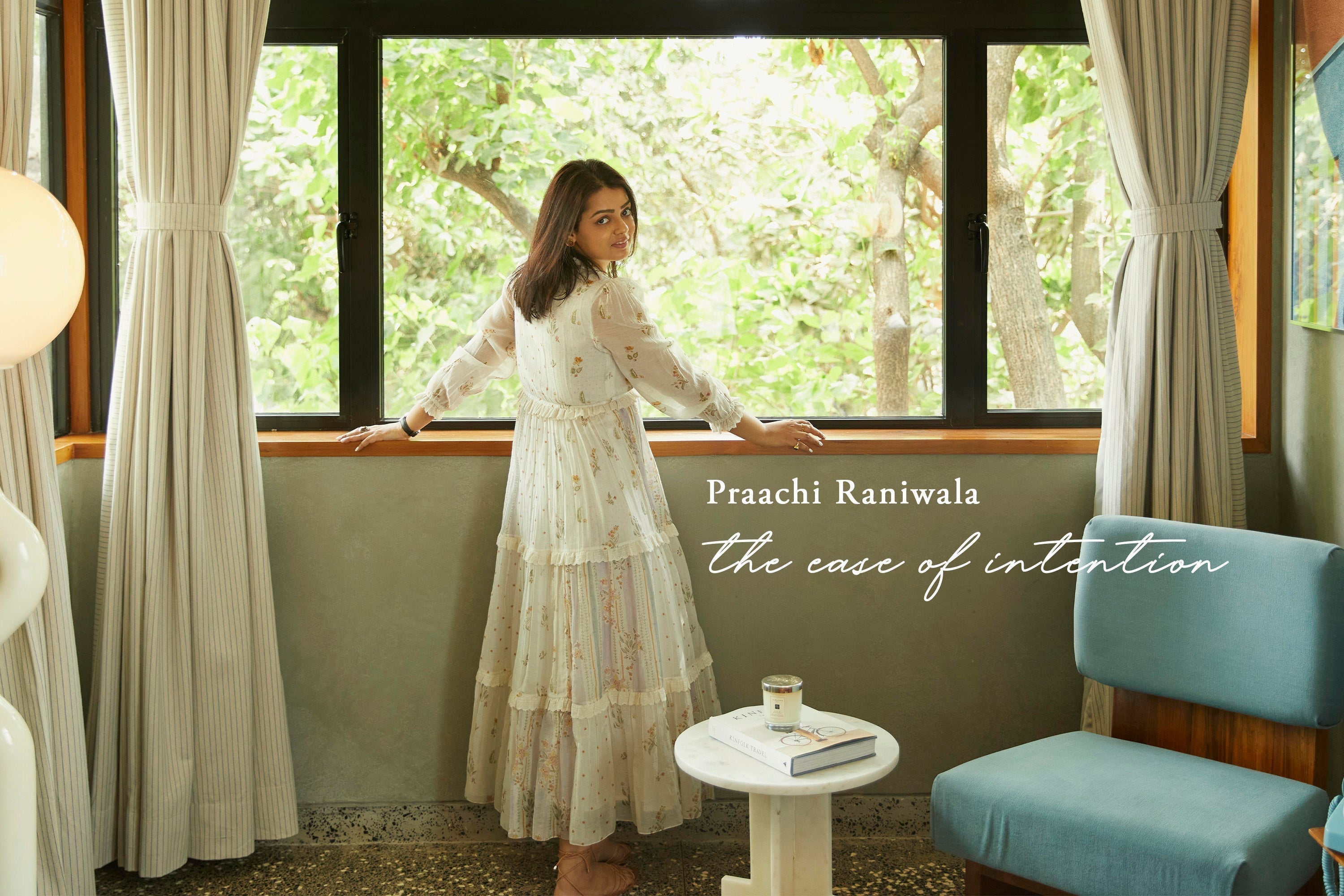Article: Shruti Sitara Singh: Of Softness, Silence, and Ceremony
Shruti Sitara Singh: Of Softness, Silence, and Ceremony
Shruti’s world is built on slow rituals, rooted craft, and cultural storytelling. We pick the creative consultant and curator’s beautiful mind on a laid-back Sunday morning at home.
In a world that moves fast, Shruti moves differently. A true cultural custodian, Shruti builds quiet worlds through textiles, stories, and spaces that honour India’s deep craft traditions and the rhythm of a slower life. We spoke to her about preservation as an act of love, the poetry of process, and what it means to reclaim time as a woman and a keeper of the handmade.
Q: Your work is a love letter to cultural identity. What first sparked your connection to old-world craftsmanship?
Shruti: What stirred within me wasn’t a flash of inspiration, but a quiet unfolding—like dye spreading through cloth. It began in 2017 when I curated Artisans of Kutch for Lakmé Fashion Week & IMG-Reliance (now RISE) and followed the thread (quite literally) back to its origin. In Bhuj, I spent time at Khamir and sat beside Sufiyan Khatri in Ajrakhpur, watching indigo-stained blocks print inherited rhythms. I visited Shrujan and Somaiya Kala Vidyalaya, spaces where knowledge passed through time, not textbooks.
Since then, I’ve journeyed through artisan clusters across India, each distinct in material, cadence, and memory. Everywhere, I found slowness, process, and beauty rooted in patience. Craft became more than a method, it became a way of listening: to wood as it’s carved, yarn as it’s spun, pigment as it meets cloth.
If my work is a love letter, it is written to those who create not to be seen, but to keep something alive. Q: What does living slowly look like for you, as a creative and a woman?
Q: What does living slowly look like for you, as a creative and a woman?
Shruti: For much of my life, I wore hustle like a second skin. But speed eroded presence and blurred intention. Now, living slowly means reclaiming time, not as scarce, but sacred.
I rise early, not to get ahead, but to return to myself. I cook slowly, lay out my clothes the night before—not from routine, but reverence for the person I’ll be. Slowness, I’ve learned, is not the enemy of productivity but the soil for creativity.
As a woman, it is resistance: to burnout, to the performance of busyness, to equating worth with output. Slowness allows softness, silence, and ceremony to return.
Shruti is wearing the Bea Wrap Dress
Q: What everyday rituals anchor your days? Any objects or practices you return to?
Shruti: Every morning, I return the house to itself, placing cushions, objects, and books back with care. It’s a form of presence more than tidiness.
Each Sunday, I bring fresh flowers home. It’s a small act, but one I hold like a promise. I often dream of a flower shop in a quiet town, or a wild garden of my own.
Our home is slowly built, not curated. A ceramic cup reminds me of a hillside village, a woven throw carries a monsoon’s scent. I believe homes should be collected, not decorated, and objects should hum with memory. These rituals steady me. They’re not grand, but they are sacred.
Q: Heirlooms don’t always have to be objects. What’s something you hope to pass on or preserve?
Shruti: Heirlooms, for me, are ways of seeing. The scent of rain on earth. The rhythm of a loom. The dignity of work done with care. If I pass anything on, let it be this: that beauty lives in the handmade, that slowness is presence, that culture breathes through us.
Through my work, I hope to preserve not just craft but the people, politics, and poetics behind it. Preservation, when done gently, is an act of love.
Q: You’ve spent years shaping India’s fashion landscape. How do you step away from an industry built on “excess” and live more intentionally?
Shruti: Fashion often speaks in the language of “more”: more visibility, more consumption. But I’ve always sought less, but better. I’ve chosen craftsmanship over trend, story over silhouette. I say no more often. I prefer projects that align with my values. I spend time with artisans not just for research, but relationships.
Work and life blur—and I’ve made peace with that. A textile I saw in a village becomes a runner on my table. A story shared over chai finds its way into my writing. Living intentionally doesn’t mean leaving the industry, it means reshaping my place within it, quietly and with care.
Q: How do you stay rooted while still feeling creatively free? What keeps you inspired?
Shruti: My roots are where I find my freedom. The deeper I go into traditional knowledge, the more space I find to dream. Sitting with papier-mâché artists in Kashmir, walking through the desert with indigenous communities in Rajasthan, I’m reminded: creativity begins with listening.
Craft is a language. The restraint of Suf embroidery, the geometry of bamboo weave, the breath in a hand-thrown pot—all hold truth and rhythm. What inspires me is noticing—the way pigment runs, the way silence gathers, the way story lingers. I stay open. I stay learning.
Shruti is wearing Song Weaver Maxi Dress
Q: What drew you to Buna’s aesthetic and philosophy?
Shruti: Buna speaks in a quiet language I deeply understand. Its garments don’t shout; they breathe. There’s poetry in its restraint and care woven into every seam. Buna honours not just fabric, but the feeling of wearing it, like returning home to yourself. In a world of noise, it offers stillness. That kind of design is not just aesthetic—it’s a value system.
Q: What is style for you? How has that definition evolved?
Shruti: Style, for me, is deeply personal, never performative. It’s how I feel, who I’m becoming, or who I want to meet within myself. Some days I’m linen in its quiet honesty; other days, I’m mirror work and dust, echoing a desert song. Style is intuition. It is a memory made visible.
With time, my relationship with style has softened and deepened. I once dressed for the world; now I dress to feel like myself. I choose garments that let me breathe, move, and be—pieces shaped by craft, culture, and care.
My wardrobe reflects my travels: the clusters I’ve walked through, the textiles that have spoken to me. I often say—wear what reminds you of who you are. Some days, that’s a cotton sari; on others, it’s a worn-in kurta. No performance—just presence.
Style, to me, is the softest rebellion: a refusal to be boxed in. It’s how I honour emotion, heritage, and change—all at once.
A Little Things Rapid Fire
An heirloom you treasure: The chappan from Istanbul
A smell that brings you home: Neroli
One object that calms you: Prayer wheel from Nepal
A meal you could eat every day: Dal Chawal with Mirchi ka Achar from my mother’s home in Benares
A trend tip you swear by: Let your clothes feel lived-in—wrinkled linen, faded dye, worn edges. Style should hold memory, not perfection.
Credits
Curation and copy: Gariyashi Bhuyan
Photographs: Keegan Crasto | Public Butter



Leave a comment
This site is protected by hCaptcha and the hCaptcha Privacy Policy and Terms of Service apply.